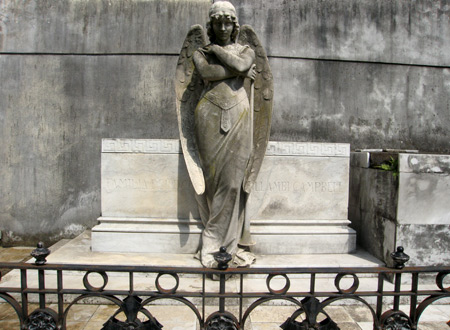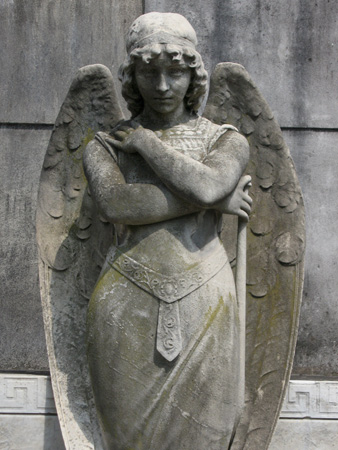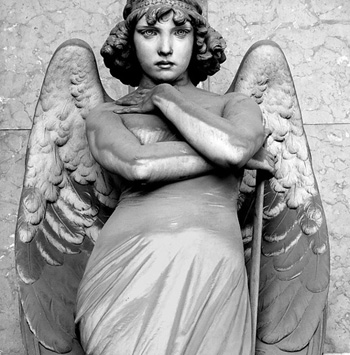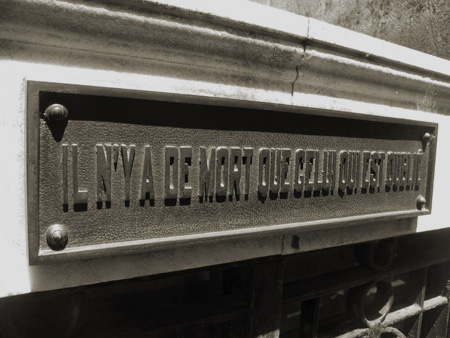
This gated family vault uses only underground storage with little ornamentation above except for one of the most beautiful angels in the cemetery. Paulino Llambi Campbell owned a large amount of land in the Argentine province of Santa Fe & named the area & town after his family.
The angel holds a trumpet in one hand while crossing her arms over her chest. The slightly bowed head is hardly demure… she has a very come-hither look on her face. Add some sensual curves & this is one of the most femme fatale statues in Recoleta Cemetery:

But this statue is not unique. Inspired by a similar angel in Staglieno Cemetery in Genoa, Italy, she makes the Recoleta version seem absolutely tame. The original was made by Giulio Monteverde, an Italian artist who trained Lola Mora & Victor de Pol as well as sculpting the crucifixion inside the entrance gate chapel. Thanks to Sergio Sanginisi for taking such a wonderful photo:

Just above the staircase which descends into the family vault is an inscription in French, “there is no death except for the one who is forgotten.” Thanks to Sergio for helping with the translation:

Update (08 Feb 2012): Thanks to the online Witcomb Collection, older versions of Recoleta Cemetery are coming to light. A nearby plot (four mini-blocks to the right) originally belonged to Vicente Ocampo & displayed a more accurate copy of the Staglieno masterpiece. Unfortunately only the Llambi Campbell copy survives today, & the Vicente Ocampo plot has been sold & divided into four sub-plots. I wonder what the Ocampo family did with their copy???

That meants, roughly: ‘There’s no death but for the one that is forgotten’.
Sergio – You’re a lifesaver. Thanks a lot!
I definitely need to refresh my French… I’ll change it in the text above soon.
Consulta…la estatua de la primer foto, la actual tiene un cinturon y el peinado menos abultado que la foto del update. Suponen fue retocada? Para mi las alas son distintas tambien.
Qué buen ojo Marcos! No es la misma que aparece en la tumba de Vicente Ocampo… también cambió de ubicación. La “manzana” donde estaba la original ahora se encuentra dividida en 4. O sea, en la foto de Witcomb es una sola tumba y ahora hay 4 en el mismo lugar (sé donde quedaba por la tumba de Francisco Bollini atras).
La cripta de Llambi Campbell parece una copia menos logrado. Qué hicieron los Ocampo con su copia????
No entendi. La cripta de Llambi Campbell esta ubicada donde antes estaba la de Ocampo?
No, la de Llambi Campbell está cerca pero no en la misma ubicación.
Ah…habia entendido una reemplaza a la otra. De todos modos es intrigante el uso de la misma estatua…
y que abra sido de la primera version. Mire las fotos de la coleccion Witcomb. Increible como cambio el perfil y cuanto verde habia antes!! A mi siempre me dan pena algunas plantas metidas en macetas o urnas…
The only dead,are those that are forgotten. That would be a closer translation to what the inscription over the door says.
It’s pretty much the same; six of one, half a dozen of another. Glad to know that your family maintains this wonderful mausoleum! Un saludo
If you know french or write poetry,half a dozen is not the same as six. In spanish the family translation is: Solo estan muertos,aquellos qud estan olvidados. The actual family vault is half the originalsize,as before my grandfather ended his days in Mexico he sold all his assets here and my parents bought half. The other half was bought by two different families. This was in 1950. But anyways,thanks for your praise of the sexy angel there
If you spoke English, you’d understand that the two translations are equivalent; they convey the same idea. Anyway, your version will help others decide for themselves.
If you read english,you would realize that Alfred Lord Tennyson’s mind boggling ” The Charge of the Light Brigade” would never have reached inmortality if instead of his ” Half a league,half league onward,into the valley of death… ” it was 1/2 a league,1/2 a league,or his “cannons to the left,cannons to the right,cannons infront” he had written artillery left,right and center,or his much quoted” Someone had blundered” to somebody made a mistake. I agree they all mean something very similar,but would that poem have caught the imagination of generations of english readers? Which , obviously you are not.
Sad to receive insults about the translation of a single sentence in French on a mausoleum. Any native speaker of English can understand the feeling behind either translation… which is why I left your comment here, so people can decide for themselves. I don’t engage with people who make judgments without knowing me, & I do not need your approval. Please be advised that any further comment on this matter will be deleted. Thank you for your contribution.